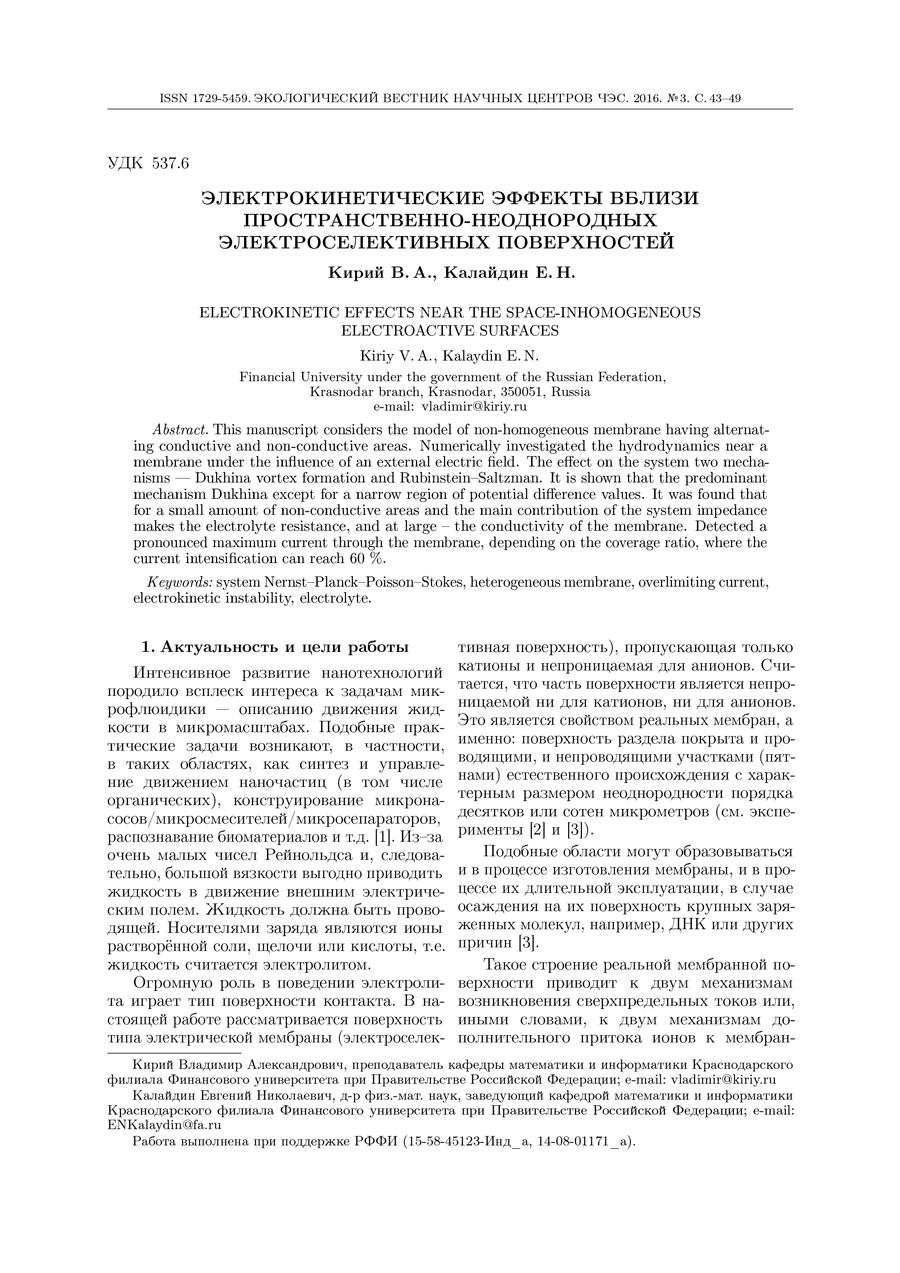Electrokinetic effects near the space-inhomogeneous electroactive surfaces
UDC
537.6Abstract
This manuscript considers the model of non-homogeneous membrane having alternating conductive and non-conductive areas. Numerically investigated the hydrodynamics near a membrane under the influence of an external electric field. The effect on the system two mechanisms — Dukhina vortex formation and Rubinstein-Saltzman. It is shown that the predominant mechanism Dukhina except for a narrow region of potential difference values. It was found that for a small amount of non-conductive areas and the main contribution of the system impedance makes the electrolyte resistance, and at large - the conductivity of the membrane. Detected a pronounced maximum current through the membrane, depending on the coverage ratio, where the current intensification can reach 60%.
Keywords:
system Nernst-Planck-Poisson-Stokes, heterogeneous membrane, overlimiting current, electrokinetic instability, electrolyteAcknowledgement
References
- Chang H.-C. , Yossifon G., Demekhin E.A. Nanoscale electrokinetics and microvortices: How microhydrodynamics affects nanofluidic ion flux. Annu. Rev. Fluid Mech., 2012, vol. 44, pp. 401-426.
- Belova E. I., Lopatkova G. Yu., Pismenskaya N. D., Nikonenko V. V., Larchet C., Pourcelly G. Effect of anion-exchange membrane surface properties on mechanisms of overlimiting mass transfer. J. Phys. Chem. B, 2006, vol. 110, pp. 13458-13469.
- Slouka Z., Senapati S., Yan Yu., Chang H.-C. Charge inversion, water splitting and vortex suppression due to DNA sorption on ion-selective membranes and their ion-current signatures. Langmuir, 2013, vol. 29, pp. 8275-8283.
- Rubinstein I., Zaltzman B. Electro-osmotically induced convection at a permselective membrane. Phys. Rev. E, 2000, vol. 62, pp. 2238.
- Rubinstein I., Zaltzman B. Electro-osmotic slip and electroconvective instability. J. Fluid Mech., 2007, vol. 579, pp. 173.
- Demekhin E.A., Shapar' E.M., Lapchenko V.V. K vozniknoveniyu elektrokonvektsii v polupronitsaemykh elektricheskikh membranakh [To the emergence of electroconvection in semipermeable electric membranes]. Doklady akademii nauk [Rep. of the Academy of Sciences], 2008, vol. 421, no. 4, pp. 478-481. (In Russian)
- Demekhin E. A., Shelistov V. S., Polyanskikh S. V. Linear and nonlinear evolution and diffusion layer selection in electrokinetic instability. Phys. Rev. E, 2011, vol. 84, pp. 036318.
- Demekhin E.A., Nikitin N.V., Shelistov V.S. Direct numerical simulation of electrokinetic instability and transition to chaotic motion. Phys. Fluids, 2013, vol. 25, no. 6, pp. 12201(1-29).
- Demekhin E.A., Nikitin N.V., Shelistov V.S. Three-dimensional coherent structures of electrokinetic instability. Phys. Rev. E, 2014, vol. 90, no. 1, pp. 013031(1-9).
- Dukhin S.S. Electrokinetic phenomena of the second kind and their applications? Adv. Colloid Interface Sci., 1991, vol. 35, pp. 173-196.
- Chang H.-C., Demekhin E. A. and Shelistov V.S. Competition between Dukhin's and Rubinstein's electrokinetic modes. Phys. Rev. E, 2012, vol. 86, pp. 046319.
Downloads
Issue
Pages
Submitted
Published
How to Cite
Copyright (c) 2016 Kiriy V.A., Kalaydin E.N.

This work is licensed under a Creative Commons Attribution 4.0 International License.




